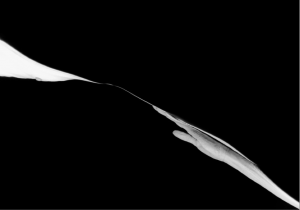In precedenza: (1) Quando la mano si fa voce (2) La carezza è risveglio dei sensi – (3) Non sempre le parole riescono a raggiungerci – (4) Per il bambino la carezza è formazione – (5) Il nostro Io pensante emerge attraverso la pelle. A seguire: (7) La carezza è apertura mentale alle singolarità dell’altro – (8) La carezza è memoria impressa nel tempo – (9) La carezza è naturalezza che scorre fluida – (10) La metafora della carezza costruisce la pace – (11) Senza carezze viene meno la speranza – (12) La carezza lotta contro l’indifferenza
Il filosofo Emmanuel Lévinas vorrebbe provocatoriamente sostituire il termine ‘concetto’ – qualcosa che è afferrato (da con-cipere) – con la parola e la pratica di carezza, qualcosa che scorre, che non cerca, o cerca senza voler possedere. Egli definisce la carezza “una marcia verso l’invisibile” a significare un’idea che si spinge all’infinito, laddove consente di pensare più di quello che non si possa facilmente pensare. Scrive Lévinas: “La carezza diventa quindi un modo di essere del soggetto, in cui il soggetto nel contatto con un altro va al di là di questo contatto. Il contatto, in quanto sensazione, fa parte del mondo della luce. Ma ciò che è accarezzato non è, a rigor di termini, toccato. Non è la dolce morbidezza o il calore della mano data nel contatto ciò che cerca la carezza. Questo cercare della carezza costituisce la sua essenza per il fatto che la carezza non sa che cosa cerca. Questo non sapere, questa confusione fondamentale è il suo carattere essenziale”.
La carezza, ‘marcia’ verso l’invisibile e l’intangibile, ci conduce all’idea di ciò di cui non possiamo farci alcuna idea, crea una tensione verso il mistero dell’Altro, sia esso una persona, una cosa o un divinità. Ancora una volta ci aiutano a comprendere i versi di una poesia, Mano va di Kikuo Takano: “Mano, va a cercare/ l’altra via./ Cedi, lascia/ una a una/ le cose che hai preso;/ tenta la via/ dove non resta nulla/ nella mano.// Mano, va a cercare/ l’altra via./ Dopo che hai perso/ tutto ciò che hai lasciato,/ oh, il vuoto!/ Le mani vuote/ si congiungano/ in un gesto severo”.
A livello interpersonale si può dire che avverto veramente la presenza di un’altra persona a condizione di sentirmi solo. Se non vi fosse una separazione, un vuoto invisibile e invalicabile tra me e l’altra persona, io non accoglierei nessuno, l’altro sarebbe uguale a me, sarebbe me e infine accoglierei solo me stesso. Inoltre una (impossibile) fusione metterebbe in discussione il nucleo identitario del soggetto: io non posso ritrovarmi nell’altro, ma da che c’è l’altro, io non posso ritrovarmi in me stesso, appunto perché io non sono una ‘cosa’, una sostanza, ma l’effetto di superficie di una struttura relazionale.
CARESS IT’S NOT JUST A WORD
(6) The caress leads us to the concept of the infinite
Before: (1) When the hand becomes word – (2) The caress is an awakening of the senses – (3) Words cannot always reach us – (4) For the child a caress is development – (5) Our thinking Ego emerges through the skin. To follow: (7) The caress is a mental aperture towards the uniqueness of the other – (8) The caress is memory imprinted in time – (9) A caress is spontaneity unrestrained – (10) Caress as metaphor builds peace – (11) Hope dies without caresses – (12) The caress fights indifference
The philosopher Emmanuel Lévenas provocatively would replace the term ’concept’ – something that has been grasped (from con-cipere) – with the word caress and its practice, something that flows, that does not seek, or that seeks without wanting to possess. He defines the caress as “a movement towards the invisible” to signify an idea that moves on towards infinity, where thinking more than what can easily be thought is consented. Lévinas writes: “The caress thus becomes a way of being of an individual, in which the individual in touching another goes beyond this touch. The touch, in so far as sensation, is part of the world of light. But what is caressed, is not, strictly speaking, touched. It is not the softness or warmth of the hand given via touch that the caress is looking for. This seeking of the caress constitutes its essence because the caress does not know what it is looking for. This not knowing, this fundamental confusion is its essential character”.
The caress ‘moves on’ towards the invisible and the intangible, leads us to the idea of something of which we can have no idea, creates a tension towards the mystery of the Other, be it a person, a thing or a divinity. Once more a poem comes to our aid, Hand go by Kikuo Takano: “Hand, go seek/ another way. / Give in, leave/ one by one/ the things you have taken:/ try the way/ where nothing remains/ in hand. // Hand, go to look for/ the other way. / After you have lost/ everything that you have left, / oh, the void! / The empty hands/ are joined/ in an uncompromising gesture”.
On an interpersonal level it can be said that only if I feel alone can I really sense the presence of another person. If there were no separation, an invisible and insurmountable void between me and the other person, I would not embrace anyone, the Other would be the same as me, would be me and in the end I would be embracing only myself. Moreover an (impossible) fusion would call into question the identifying core values of the subject. I cannot identify with the Other, but since there is the Other, I cannot identify with myself, precisely because I am not a ‘thing’, a substance, but the superficial effect of a relational structure.

